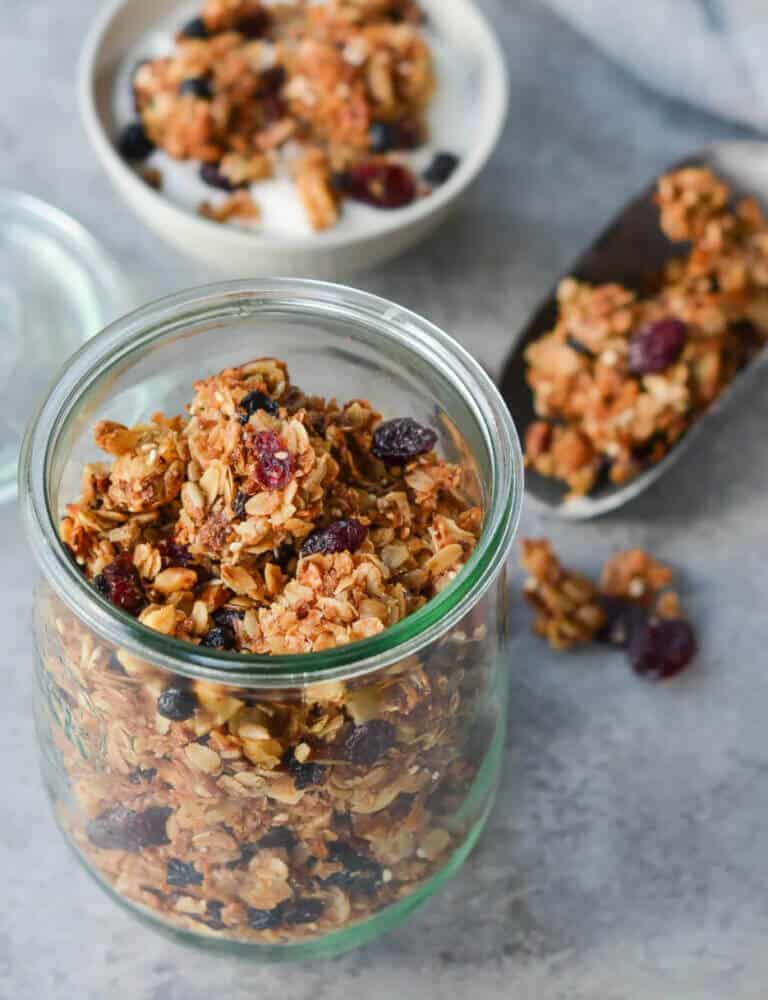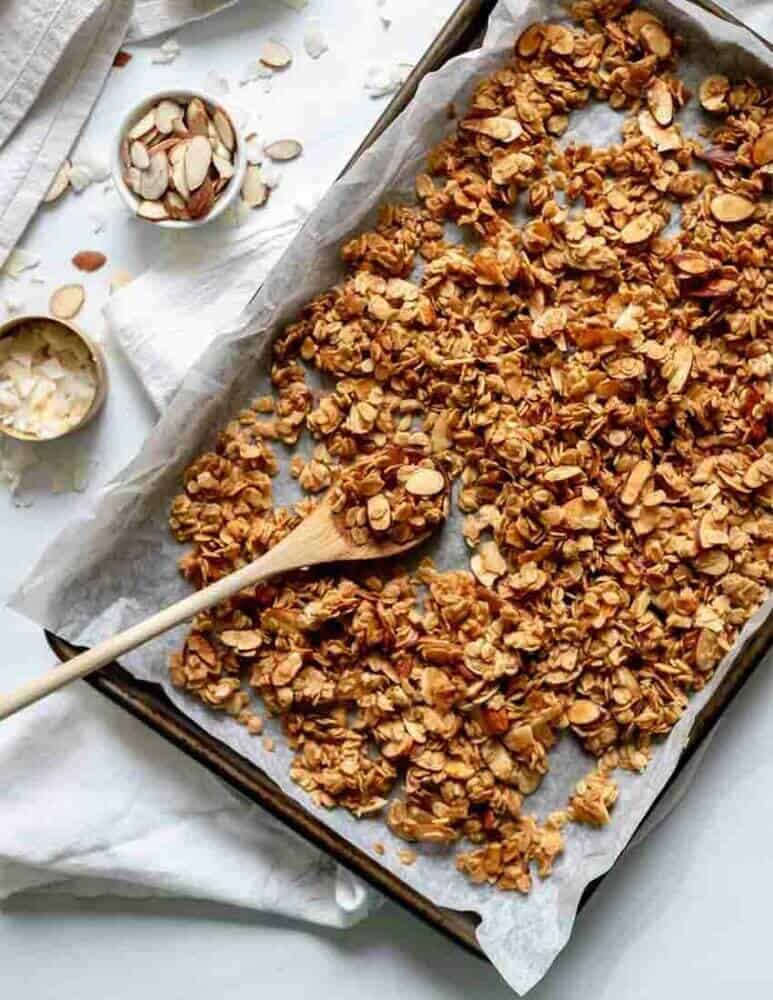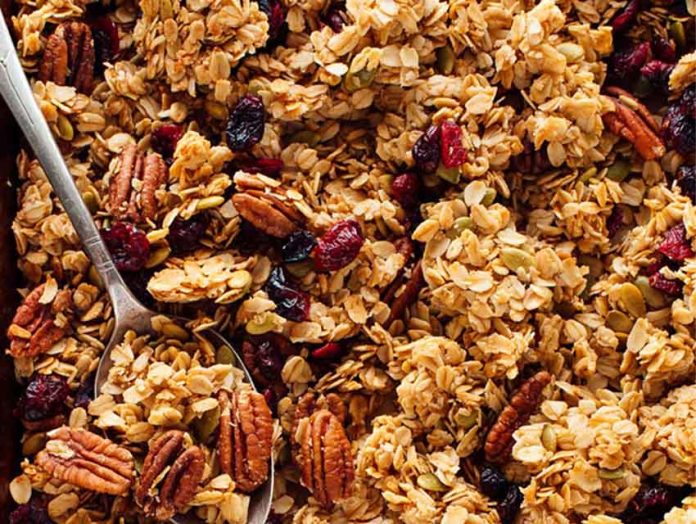Granola has been a staple in my kitchen for, oh, 40-plus years.
I’ve tended to make it myself because I want certain ingredients and flavors and don’t want others. (No peanuts; not too many raisins; not too sweet.)
Buying it ready-made can also be expensive; understandable because some of the essential ingredients are, but still, I hate spending money on something I’m not sure I’ll like.
One of my favorite things about granola are the crunchy, stuck-together clumps. That’s hard to find too, and for years I’ve tried to figure out how to make that happen consistently. I used to think the trick had to do with the right amount of oil or a thick sugar syrup, but it turns out I was wrong. (Sugar does assist in the crisping process, but not in the way I thought.)
After years of experimenting, making mistakes and sometimes careless cooking, I realized that when the oats are soaked in water before baking, they clump into the sought-after crunchy nuggets.

What happens is that water softens the oats, allowing them to swell and release their natural starch, which bakes them into you-know-what (and allows smaller things like bran and chia to stick to the clusters). Softening the oats first also prevents the granola from turning into too-hard, impossible-to-eat “horse food,” which many of us have unfortunately experienced.
Once the soaked oats are put in the oven, steam releases as they bake, clumps form as the starch attaches to itself and the grains become crisp and light. Sugar mixed in and dissolved in the soaked oats during a second pause before baking caramelizes into yet more crunch and a delicious, subtle sweetness. Using buttermilk (or yogurt mixed with water) for the soaking yields a mild tang, and the acidity slows down the browning process as the oats bake.
I know buttermilk is difficult if not impossible to find in Mexico; Amazon México carries both freeze-dried and buttermilk powder, but they’re pricey. (Remember to ask a snowbird or visiting friend to bring you some!) Yogurt, though, can provide the same acidity and is easy to come by. Use only plain, unsweetened, as-natural-as-possible yogurt, and not Greek yogurt, which is too concentrated to work in this recipe.
To make granola, start with old-fashioned whole rolled oats, not instant, quick, or steel-cut; in Mexico the container or bag will say hojuelas de avena integral.
Resist the urge to use prepackaged, already-toasted nuts – chances are they’ll have added oil and salt and won’t work in your granola. (I did and had to pick them out. Yech.) Better to roast them yourself — carefully, because they’re so easy to burn! If you use slivered almonds, they’ll toast faster than the other nuts, so roast them separately or take them out first.
And don’t be tempted to use a metal spatula or spoon for stirring — use the two-fork method or a firm silicon spatula. The trick is to disturb the clusters as little as possible so you end up with those coveted crunchy nuggets.

Never-Fail Crunchy Granola
- 3½ cups whole rolled oats
- 1/3 cup wheat germ/bran
- 1 Tbsp. chia seeds
- 1 cup buttermilk OR ½ cup plain regular yogurt mixed with ½ cup water
- ½ cup unsalted butter or coconut oil, melted
- 1 cup sugar
- 1 tsp. vanilla
- ½ tsp. salt
- ¾ cup pepitas (raw pumpkin seeds)
- ½ cup chopped or slivered almonds
- ½ cup pecan pieces
- ½ cup unsweetened coconut, toasted or not
- Pinch salt
- 1½ cups dried fruit (combination of raisins, apricots, chopped dates, cranberries, etc.)
In a medium bowl, combine oats, wheat germ/bran and chia. Mix well, then stir in buttermilk or yogurt/water mixture and melted butter/coconut oil till combined. Cover with a kitchen towel and set aside until oats are stiff and dry, about 20 minutes.
Stir in sugar, vanilla and salt, cover, and let stand until the mixture looks loose and damp and the oats have expanded, about 30 minutes, stirring well once or twice.
With oven rack in the middle position, preheat to 350 F (177 C). Combine pumpkin seeds, almonds and pecan pieces on a parchment-lined pan and toast about 10 minutes, watching carefully so as not to burn, until fragrant and just beginning to brown. (I always burn slivered almonds so consider roasting them separately.)
Transfer to a large bowl, sprinkle with salt and stir in dried fruits and coconut. Reserve the parchment-lined pan to use again.
Reduce oven temperature to 300 F (150 C). Scrape oat mixture onto the parchment-lined pan and spread into a thick, even layer. It will be like a thick batter.
Bake until uniformly golden brown and dry to the touch, about 100 minutes total, pausing every 20–25 minutes to remove the mixture from the oven, and turn carefully with a pair of forks or a firm spatula.
When golden and dry, remove from oven and allow to cool completely on a wire rack. To speed cooling, slide the parchment off the baking sheet without disturbing or breaking up the oat clusters, if you can.
When the oats are completely cooled, about 45 minutes, transfer to the bowl of dried fruit and nuts. Toss gently until combined. Once cooled, transfer to an airtight container and store up to six weeks at room temperature.
– Adapted from seriouseats.com
Janet Blaser is the author of the best-selling book, Why We Left: An Anthology of American Women Expats, featured on CNBC and MarketWatch. She has lived in Mexico since 2006. You can find her on Facebook.
